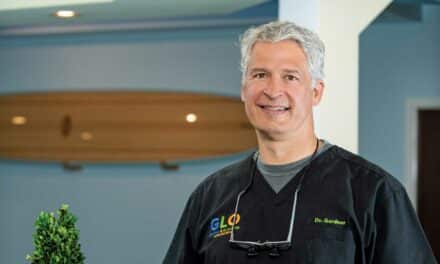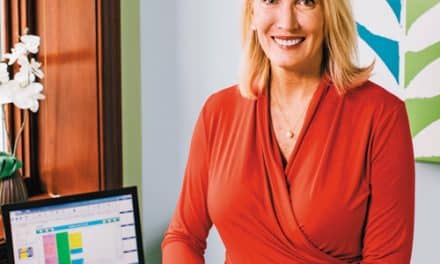Much like other orthodontists practicing today, Straty Righellis, DDS, of Righellis & Associates, Oakland, Calif, recalls being intrigued by the profession at a young age. He received orthodontic treatment as a teenager in junior high school and was impressed by what he witnessed. “I liked my orthodontist; I thought what he did for a living seemed fun,” Righellis recalls. “He worked with his hands, interacted with patients, and ran a small business.”
[sidebar float=”right” width=”275″]Practice Profile
Practice name: Righellis & Associates
Location: Oakland, Calif
Number of chairs: 5
Years in practice: 40
Education: DDS from University of California, Los Angeles; orthodontic certification from the University of California, San Francisco
Average number of patients per day: 65 to 68
Days worked per month: 12
Top products used: Forestadent Self Ligation Brackets FACE Rx Active/Passive; Dolphin Management and Imaging Systems; Rewards Hub Incentive Program; products from Reliance Orthodontics Inc; AcceleDent® by OrthoAccel Technologies Inc; Oral-B® toothbrushes; and Orchestrate from Orchestrate Orthodontic Technologies.
Website: righellisortho.com [/sidebar]
While in treatment, Righellis may have seen himself in the same role as his orthodontist one day, but he didn’t realize back then that he would someday be at the forefront of a curriculum that would change the profession.
Since the early 1990s, Righellis and several of his peers from around the country have worked as professors and advocates for the FACE program—an acronym for functional and cosmetic excellence.
As Righellis explains, the FACE course is not just about straightening teeth. Instead, the concept builds on the principles established by Ronald H. Roth, DDS, MS, and others, and incorporates comprehensive diagnostics, detailed treatment mechanics for a variety of malocclusions, and the latest orthodontic advances for treating the entire dental and facial system.
“The difference with the FACE philosophy [compared to traditional orthodontics] is it incorporates and integrates everything we see and can affect as orthodontists,” Righellis says. “Not just tooth alignment, but airway, facial, and smile aesthetics, as well as occlusion, periodontal, and jaw health.”
The FACE teaching program consists of a 2-year comprehensive course study in orthodontics with an emphasis on interdisciplinary dentistry. And, as Righellis notes, it is the only postgraduate, interdisciplinary continuing education program available within the orthodontic profession.
“The FACE curriculum demonstrates advanced technologies in diagnosis, such as CBCT images, improvements in mechanics with self-ligation brackets, streamlining wire sequencing, skeletal anchorage, as well as accelerated tooth movement techniques to demonstrate continued reduction in treatment time, [and] fewer office visits while maintaining high-quality outcomes,” he adds.
The program is offered in Boston; Fort Lauderdale, Fla; and Phoenix, as well as 20 other countries around the world, and Righellis explains that it is intended to provide a lifetime learning forum among thousands of doctors from around the globe who have integrated the FACE principles into their practice.
“The concepts that are taught in the FACE program are concepts that can be applied to every patient who walks through the door,” he says. “Ultimately, it’s a philosophy that changes the way an orthodontist sees the patient.”
 The Learning Journey
The Learning Journey
Righellis’ introduction into the FACE program happened in the early 1990s when he was mentoring with Roth and other colleagues. He was intrigued by the FACE concept and how simplistic it really was, while at the same time being so beneficial to patients and doctors.
“Essentially, what we’re dealing with are puzzle pieces,” he explains. “With FACE, we aim to fit the puzzle pieces of the teeth together and the pieces of the face together so that when we complete the treatment, the bite is optimal and the teeth are well placed in the face for facial smile aesthetics. At the same time, we want long-term periodontal jaw joint health.”
For more than two decades, Righellis and a number of colleagues have taken the concept taught to them by Roth and applied it to building, organizing, and teaching the current FACE curriculum.
According to Righellis, the learning journey begins with a comprehensive, six-module program that offers a theoretical and practical foundation in the following areas:
- In-depth evaluation of joint function and occlusion
- Mounted models and instrumentation for improved diagnostics
- Multidisciplinary case recruitment and treatment planning, finishing, and equilibration
- Treatment mechanics with self-ligating appliances
- Computer-assisted treatment planning
- How to establish your inter-disciplinary teams
- Practice management and marketing, leveraging your interdisciplinary network for referrals
- Facial aesthetic treatment planning
Righellis adds that he and his colleagues designed these course modules to “enhance the knowledge base of the university-trained orthodontist in order to allow him or her to treat a variety of malocclusions with a high degree of predictability.
“Essentially, we are creating a treatment plan based on the goals for the bite, the face, the smile aesthetics, the airway, the periodontium, and jaw joints while satisfying the chief concerns of the patient,” Righellis explains. “The intensity of this treatment is not so much in the actual treatment, but in the planning that the orthodontist does before the patient is treated. We spend more time in the diagnosis so we can spend less time in treatment.”
 Practice Benefits
Practice Benefits
Over the course of nearly two decades teaching the FACE program and implementing its principles into his own practice, Righellis has found that the program concepts are a benefit to patients and to the operation of his business.
“Truly, every potential patient who walks through our door has the opportunity to be treated with this approach,” he says. “The FACE treatment focuses on goal-directed treatment planning, and it applies to every patient who asks us for our opinion. We apply clear-cut, evidence-based goals to strive to match the expected outcome with the actual outcome. As a result, treatment often goes faster with fewer office visits because, with a thorough diagnosis, we can be much more efficient with our treatment direction.”
On the flip side, Righellis also has noticed his background in FACE helps him and his associates identify patients who are not candidates for orthodontic treatment. “As anyone in private practice can attest to, this may be one of the more important, yet difficult, lessons to learn,” he adds.
[sidebar float=”right” width=”275″]
A Passion for Teaching
For 25 years, Straty Righellis, DDS, of Righellis & Associates, Oakland, Calif, has been on the FACE (functional and cosmetic excellence) international teaching faculty, sharing with orthodontists around the world the principles of the FACE curriculum. He also currently serves as Associate Clinical Professor at the University of California, San Francisco (UCSF) School of Dentistry and the University of the Pacific School of Dentistry. What’s more, he lectures at Harvard University and Boston University, as well as at the University of Arizona orthodontics programs.
“Teaching is a huge part of my professional life, and is a major reason that I am so passionate about orthodontics,” Righellis says. “Sharing information with orthodontists by way of teaching helps all of us improve our patient care.”
This is a concept that Righellis has maintained throughout his career. As he explains, after he graduated from the UCSF orthodontic program, he associated for 2 years with several orthodontists in the San Francisco Bay area. “I gained valuable experience with these practices,” he recalls. “The types of information I learned as an associate gave me an opportunity to decide where I wanted to practice and, more importantly, how I wanted to practice.”
In 1975, Righellis ventured out and started his own private practice. “I didn’t have a single patient when I opened my doors,” he notes. “After 4 months, I had six! I was excited the practice was growing, but I still associated 4 days a week to pay the bills.”
Nine years after he opened his own practice, Righellis had grown the business to a point where he was able to hire his first associate. “My professional business model then—and it remains today—was to develop a vibrant private practice that was technologically savvy, up-to-date, and to teach part-time at UCSF,” Righellis explains. “Having an associate in the office provided intellectual stimulation and gave me time during the week to follow my passion for teaching orthodontics.”
During the first 17 years that Righellis ran his own practice, he was able to pursue his dream of practicing and teaching, simultaneously. He was able to teach 1 day a week at UCSF, both in the undergraduate department and in the postdoctoral program. “Since then, my teaching has grown with the FACE teaching program both domestically and internationally, which has been incredibly rewarding,” he notes. “What I strive to stand for is to be a solid practitioner who has a passion for teaching. With that combination, one feeds off of the other.”[/sidebar]At Righellis & Associates, each patient who undergoes an examination receives the FACE diagnostic approach. “We offer, if applicable, three treatment choices: Comprehensive orthodontic care, limited care, or maintenance care, based upon our explanation of the evidence-based treatment goals and the patient’s understanding of the benefits of treatment and the consequences of those choices,” Righellis explains.
“Of the patients whom we examine, 95% of them pursue comprehensive care addressing all the goals if we give them the confidence that these goals can be achieved predictably,” he adds.
For Righellis and his team, the FACE approach has been more than a method of treating patients scientifically and efficiently, it’s a necessity to the business model of the practice.
“Since I implemented the FACE approach in 1990, my practice has grown steadily, even during the recession years of 2007 through 2009,” he notes. “We are able to achieve a 90% on-time completion rate, with high-quality outcomes.”
To emphasize the importance of the FACE concept, Righellis conducted a cohort study in which he sampled 100 consecutive patients before implementing the FACE philosophy and compared that group with another 100 consecutively started patients who had been introduced to FACE.
What he found was the FACE cohort study sample had shorter treatment times and fewer office visits. What’s more, all 200 cases were graded by independent orthodontists to measure quality of the occlusal outcomes with the FACE sample, again revealing reduced treatment times and better occlusal outcomes.
“The treatment outcomes speak for themselves, but none of this is possible unless the entire staff understands this approach,” Righellis stresses. “The staff sees the work every day and they are the voice of this philosophy. Their passion for orthodontics and achieving our goals must be readily apparent in their communication with the patient and their parents.”
As he explains, from patient schedulers, to the treatment coordinator, to the registered dental assistants who help with patient treatment, every person on staff at Righellis & Associates conveys the same message regarding how patients are treated using the FACE method.
“We’ve found that the consistent and thorough pretreatment diagnosis, with the utilization of advanced diagnostic techniques and adhering to clear measurable treatment goals, reduces ‘midstream’ adjustments and/or alterations from the original treatment plan—adjustments such as these will increase the number of office visits and extend treatment time,” Righellis notes.
“Other treatment philosophies have the patient enter into treatment at the first examination, resulting often in more of an act-and-react type of treatment,” Righellis explains. “FACE treatments, on the other hand, are already determined based on the thorough diagnosis in our clear-cut, evidence-based treatment goals that we strive for. So, what sets us apart from other practices is that we spend more time diagnosing the case so that, ultimately, we can spend less time treating it.” OP
Lori Sichtermann is a freelance writer for Orthodontic Products. She can be reached at [email protected].













